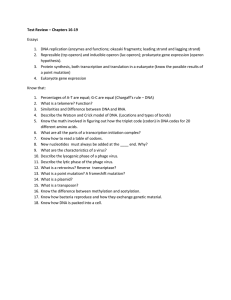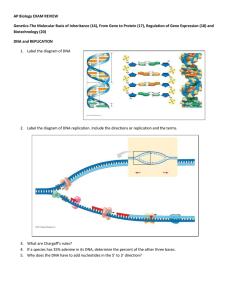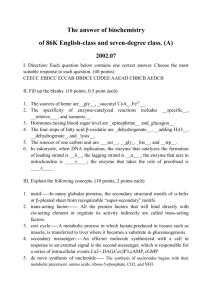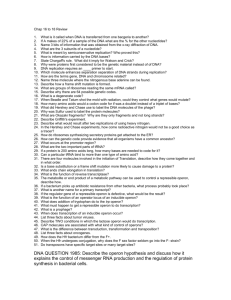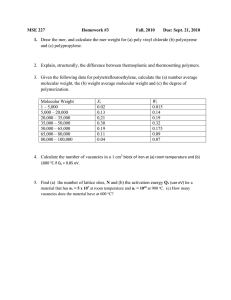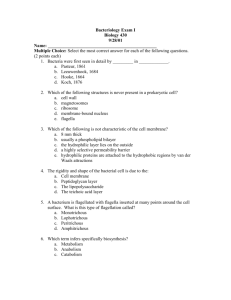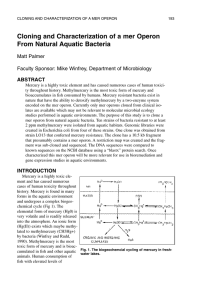mer Occurring Aquatic Bacteria Jennifer Daniel
advertisement
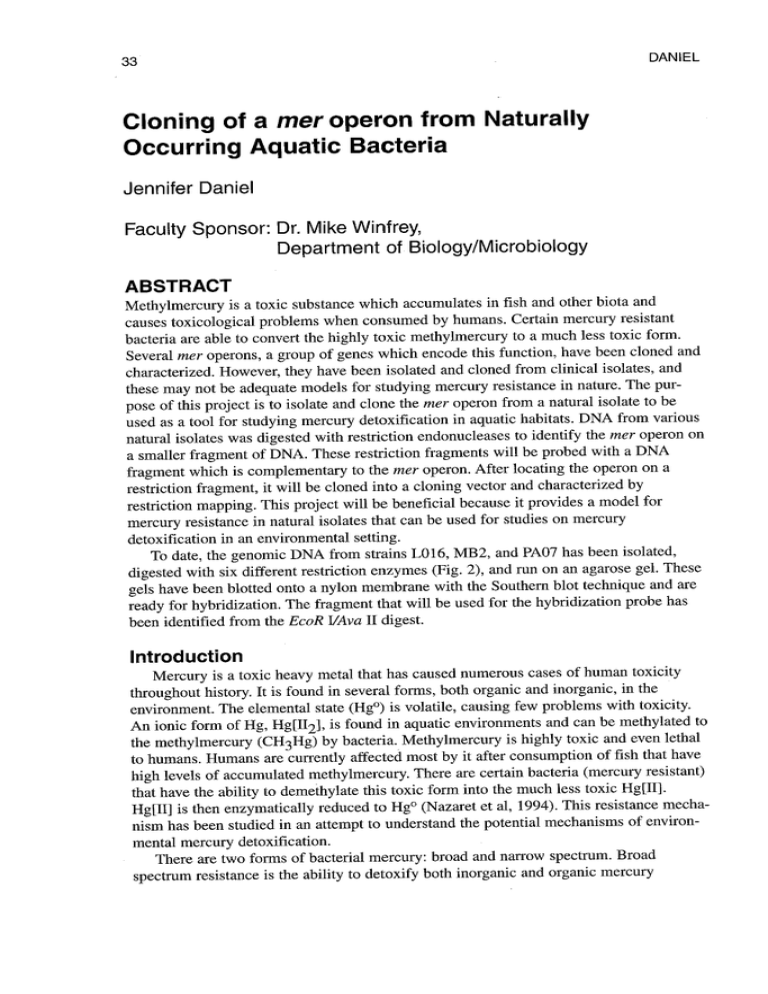
33 DANIEL Cloning of a mer operon from Naturally Occurring Aquatic Bacteria Jennifer Daniel Faculty Sponsor: Dr. Mike Winfrey, Department of Biology/Microbiology ABSTRACT Methylmercury is a toxic substance which accumulates in fish and other biota and causes toxicological problems when consumed by humans. Certain mercury resistant bacteria are able to convert the highly toxic methylmercury to a much less toxic form. Several mer operons, a group of genes which encode this function, have been cloned and characterized. However, they have been isolated and cloned from clinical isolates, and these may not be adequate models for studying mercury resistance in nature. The purpose of this project is to isolate and clone the mer operon from a natural isolate to be used as a tool for studying mercury detoxification in aquatic habitats. DNA from various natural isolates was digested with restriction endonucleases to identify the mer operon on a smaller fragment of DNA. These restriction fragments will be probed with a DNA fragment which is complementary to the mer operon. After locating the operon on a restriction fragment, it will be cloned into a cloning vector and characterized by restriction mapping. This project will be beneficial because it provides a model for mercury resistance in natural isolates that can be used for studies on mercury detoxification in an environmental setting. To date, the genomic DNA from strains L016, MB2, and PA07 has been isolated, digested with six different restriction enzymes (Fig. 2), and run on an agarose gel. These gels have been blotted onto a nylon membrane with the Southern blot technique and are ready for hybridization. The fragment that will be used for the hybridization probe has been identified from the EcoR I/Ava II digest. Introduction Mercury is a toxic heavy metal that has caused numerous cases of human toxicity throughout history. It is found in several forms, both organic and inorganic, in the environment. The elemental state (Hg°) is volatile, causing few problems with toxicity. An ionic form of Hg, Hg[II 2], is found in aquatic environments and can be methylated to the methylmercury (CH3 Hg) by bacteria. Methylmercury is highly toxic and even lethal to humans. Humans are currently affected most by it after consumption of fish that have high levels of accumulated methylmercury. There are certain bacteria (mercury resistant) that have the ability to demethylate this toxic form into the much less toxic Hg[II]. Hg[II] is then enzymatically reduced to Hg° (Nazaret et al, 1994). This resistance mechanism has been studied in an attempt to understand the potential mechanisms of environmental mercury detoxification. There are two forms of bacterial mercury: broad and narrow spectrum. Broad spectrum resistance is the ability to detoxify both inorganic and organic mercury CLONING OF A MER OPERON 34 compounds. Narrow spectrum resistance refers to the detoxification of only inorganic mercury (Gilbert and Summers, 1988). This study focuses on broad spectrum resistance because this can detoxify methylmercury. The genes that encode for mercury resistance (mer operon) encode several proteins with various functions (Fig 1). The merT and merP gene products transport mercury in the cell. The merB gene product encodes organomercurial lyase which cleaves the carbon-mercury bond in organomercurials producing Hg[II]. The merA gene product (mercuric reductase) then reduces Hg[II] to the volatile Hg° which is released from the cell. The merR gene encodes a regulatory protein that represses the operon in the absence of mercury (Brown et al, 1986). This purpose of this project is to isolate and clone the mer operon from a natural isolate to be used as a tool for studying mercury detoxification in aquatic habitats. This will be a much more appropriate model for these studies than the current mer operon that was isolated from clinical isolates. DNA MerP -' Hg - Figure 1. The mer operon. This model descirbes the genes in the mer operon and the proteins involved in transport and detoxification of methylmercury. (Silver and Misra, 1988.) MATERIALS AND METHODS Bacterial Strains and Plasmid. Strains were isolated by Bryan Marks from the Pettibone Lagoon and from stab vials of mercury resistant bacteria isolated by L. Overbye in the summer of 1988 (Table 1.) The plasmid pDG105 contains the Tn21 mer operon inserted into a cloning vector (Gambill and Summers, 1985.) 35 DANIEL Table 1. Bacterial strains. Source Strain Pettibone Lagoon MB2 Overbye (1988) L016 L. L. Overbyel988) PA07 DNA Isolation. L016 was streaked out on R2A Agar with 3 ppm phenyl mercuric acetate (PMA) and incubated at 28°C. An LB broth +3 ppm PMA tube was inoculated with L016 and this culture was transferred to a 100 ml flask of LB+3 ppm PMA to give a 1% inoculum. DNA was isolated following the procedure described by Winfrey et al., 1997. The concentration of the DNA was determined by fluorometry (Cesarone et al., 1979.) Restriction digestion and Southern blot. Chromosomal DNA from each mercury resistant strain (MB2, L016, and PA07) was digested with six different enzymes (Hind III m, Sst I, Pst I, BamH I, Sal I, and Xha I) in separate digestions at 37°C for eight hours. The resulting fragments were separated by agarose gel electrophoresis on a 0.8% gel, stained with ethidium bromide and photographed on a transilluminator. These resulting fragments were transferred to a nylon membrane by the Southern blot technique (Winfrey et al., 1997.) Identification of the probe fragment. pDG105 was digested in two digestions at 37°C. Digestion 1 contained EcoR I and digestion 2 contained EcoR I and Ava II. Digested DNA and uncut plasmid was run on a 1.8% agarose gel electrophoresis with a 1 Kb BRL ladder as a size standard. The 1.12 Kb EcoR I-Ava II fragment was identified and will be used as a probe following labelling. Results Table 2. Characteristics of mercury resistant bacteria (Data of Bryan Marks). Oxidase Resitance Morphology reaction ppm CH3Hg + Gram reaction Strain rods -single 2 MB1 short rods 3 MB2 rods -circular 2 MB3 rods -single 3 MB4 oval rods + -/+ 4 MB5 rods + 3 L020 short rods + -/+ 3-4 L014 short,single rods + 4 L013 rods 2 YB3 rods -short 5 PA07b oval rods 4 L016 aMB2, L016, and PA07 were chosen for this study based on their variance in morphology and their high level of methyl mercury resistance. bPA07 is a strain of Pseudomonas aeruginosafrom the microbiology prep room. CLONING OF A MER OPERON 36 Figure 2. Each genome was digested with the following restriction endonucleases: Hind III, Bam HI, Sal I, Sst I, Pst I and Xba I. These digestions were performed to obtain the mer operon on a clonable fragment. Six different enzymes were used to increase the likelihood that the mer operon would be obtained on a clonable (5-12kb) fragment. Following agarose gel electrophoresis, blots of the gels were made onto nylon membranes via the Southern blot technique. A. Genomic digest of L016. Genomic digest on MB2. This strain carries several plasmids. C. Genomic digest of PA07. DANIEL 37 _ z," ^S ,O/P -m ,o3 0/P -_rr = o m, M -, mow I Tn21 R '---T '---C > A -Do I kb Figure 3. A model of Tn21 mer operon. This tranposon is found on the plasmid pDG105. Specific fragments that can be used as hybridization probes to identify mer operons are denoted by open boxes. Probe 7 will be used for this project following purification and labeling (Gilbert and Summers, 1998). Figure 4. A plasmid (pDG105) that contains the Tn21 mer operon, was cut with Ava II and EcoR I to obtain the merA gene on a 1.12 kb fragment (indicated by arrow). This fragment will be puri32 fied from the agarose gel, labeled with P-labeled nucleotides, and used as a hybridization probe to identify restriction fragments containing the mer operon in the digested genomic DNA from L016, MB2 and PA07. CONCLUSIONS/FURTHER WORK To date, the genomic DNA from strains L016, MB2, and PA07 have been isolated, digested with six different restriction enzymes (Fig. 2), and run on an agarose gel. These gels have been blotted onto a nylon membrane with the Southern blot technique and are ready for hybridization. The fragment that will be used for the hybridization probe has been identified from the EcoR I/Ava II digest. The next step in this project is to probe the genomic DNA digests with the merA probe to identify the fragment containing the mer operon in the chromosome of each strain. The membranes from the Southern blots will be hybridized with a radio-labeled merA probe. The probe will bind to the digested DNA wherever the sequences have CLONING OF A MER OPERON 38 some homology. The challenge to this procedure lies in the fact that the amount of similarity between the merA probe and the merA genes in the chromosomes is unknown. Therefore, the proper hybridization stringency must be determined. Stringency refers to the conditions that define specificity of the probe binding to its target. For example, under high stringency the probe will bind only to targets with near perfect homology. In contrast, under low stringency the probe will bind to DNA fragments with less homology. At the beginning, low stringency hybridization will be used, which will allow the probe to bind to sequences with low homology. The stringency will be increased in subsequent hybridizations until less binding occurs and ultimately until the probe binds only the desired fragment. Too high of a stringency will not allow any probe to bind. Positive and negative controls will be used to assess the stringency requirements. The positive control is the 1.12Kb Ava II/EcoR I fragment that will be used as the hybridization probe, therefore, the probe should always bind to this fragment. The negative control is the 1Kb BRL Ladder. The mer operon is not found on this DNA and any binding that would result would be caused by too low of a stringency. The stringency could then be adjusted to limit this binding. After completion of the hybridization, the operon will be cloned into Escherichia coli cells. This will provide researchers studying mercury resistance in the environment with a model of the genes that encode for this resistance from a natural source. This will be much more relevant than using the current mer operons from clinical isolates. REFERENCES Brown, N.L., T.K. Misra, J.N.Winnie, A. Schmidt, M. Seiff, and S. Silver. 1986. The nucleotide sequence of the mercuric resistance operons of plasmid R100 and transposon Tn501: further evidence for mer genes which enhance the activity of the mercuric ion detoxification system. Mol. Gen. Genet. 202:143-151. Cesarone, C.P, C. Bolognesi, and L. Santi. 1979. Improved microfluorometric DNA determination in biological material using 33258 Hoechst. Anal. Biochem. 100:188-197. Gambill, B.D., and A.O. Summers. 1985. Versatile mercury-resistant cloning and expression vectors. Gene 39:293-297. Gilbert, M.P.,and A.O. Summers. 1988. The distribution and divergence of DNA sequences related to the Tn21 and Tn501 mer operons. Plasmid 20:127. Nazaret, S., W.H. Jeffrey, E. Saouter, R. Von Haven, and T. Barkay. 1994. merA gene expression in aquatic environments measured by mRNA production and Hg(II) volatilization. Appl. Environ. Microbiol. 60:4059-4065. Silver, S., and T.K. Misra. 1988. Plasmid mediated heavy metal resistances. Ann.Rev. Microbiol. 42:717-743. Winfrey, M.R., M.A. Rott, and A. T. Wortman. 1997. Unraveling DNA: molecular biology for the laboratory. Prentice-Hall Inc., New Jersey.
